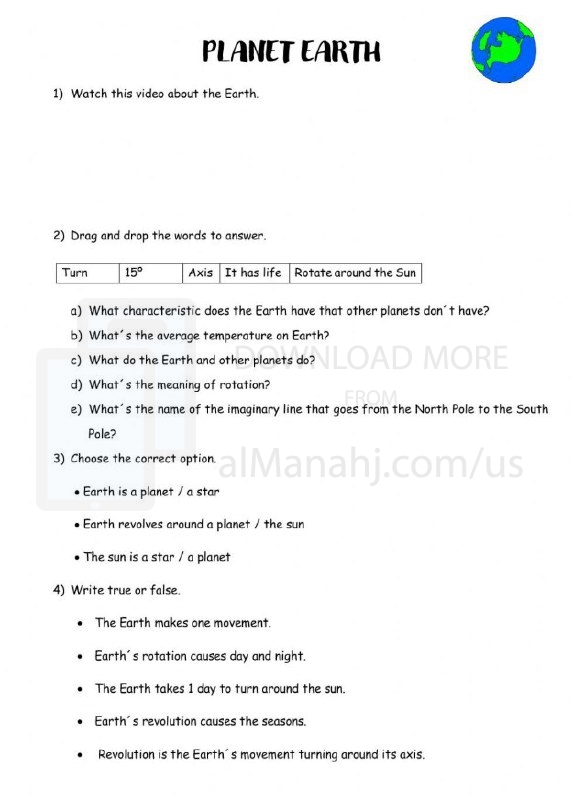| You are here: Almanahj Website ⇒ American curriculum ⇒ 4th Grade ⇒ Geology ⇒ Term 1 | ||
|---|---|---|
Worksheet about The Earths characteristics and movements | ||
|---|---|---|
| Subject: Geology | ||
| 4th Grade | ||
| Term 1 | ||
| Year: 2023/2024 | ||
| Size: 217.2KB | ||
| Number of clicks: 95 | ||
| Publish date:November 22, 2023 | ||
| Added by: Eman | ||
| Last download date: 2024-09-03 10:36:27 | ||
| Updated by: Eman9966 on 2023-11-23 15:45:46 | By: theodor Noraini Binti Masoud | |
| File info: The Earth is the third planet from the Sun and the only astronomical object known to harbor life. It is a rocky planet with a diameter of about 12,742 kilometers, making it the largest of the four inner planets. The Earth rotates on its axis once every 24 hours, causing the alternation of day and night. It also orbits the Sun once every 365.24 days, causing the change of seasons. Here are some of the Earth's key characteristics: Shape: The Earth is an oblate spheroid, meaning that it is slightly wider at the equator than it is at the poles. This is due to the centrifugal force caused by the Earth's rotation. Composition: The Earth's interior is divided into three layers: the crust, the mantle, and the core. The crust is the outermost layer, and it is made up of rock. The mantle is the middle layer, and it is made up of hot, molten rock. The core is the innermost layer, and it is made up of iron and nickel. Atmosphere: The Earth's atmosphere is made up of mostly nitrogen and oxygen, with smaller amounts of carbon dioxide, argon, and other gases. The atmosphere protects the Earth from harmful radiation from the Sun, and it helps to regulate the planet's temperature. Hydrosphere: The Earth's hydrosphere is made up of all of the water on the planet, including the oceans, lakes, rivers, and groundwater. Water is essential for life, and it covers about 71% of the Earth's surface. Magnetic field: The Earth's magnetic field is a protective shield that surrounds the planet. It helps to deflect harmful radiation from the Sun, and it is also important for navigation. The Earth's movements are also important for life. The Earth's rotation causes the alternation of day and night, which is necessary for plants and animals to carry out their daily activities. The Earth's orbit around the Sun causes the change of seasons, which affects the growth and distribution of plants and animals. Here are some of the Earth's key movements: Rotation: The Earth rotates on its axis once every 24 hours. This causes the alternation of day and night. Revolution: The Earth orbits the Sun once every 365.24 days. This causes the change of seasons. Precession: The Earth's axis wobbles like a top as it rotates. This cycle takes about 26,000 years to complete. Nutation: The Earth's axis sways slightly back and forth as it rotates. This cycle takes about 19 years to complete. Milankovitch cycles: These are the combined effects of the Earth's precession, nutation, and eccentricity on the Earth's climate. The Earth's characteristics and movements are all important for life. The Earth's size, composition, atmosphere, hydrosphere, and magnetic field all play a role in making the Earth habitable. The Earth's rotation and revolution also play a role in making the Earth habitable, as they cause the alternation of day and night and the change of seasons. | ||
| Downloading link Worksheet about The Earths characteristics and movements |
|---|
|
1700632857.pdf
The file is being prepared for download
|
| File images |
|---|
 |